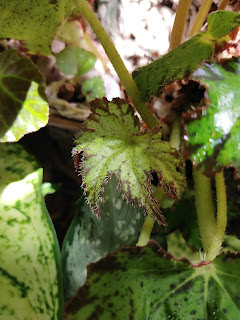I must say that I'm sadden by the fact that most of the plants that sold in local nurseries are not suitable for our lowland hot & humid climate zones. Often these plants are sold in bulk here where most unsusceptible, newbie gardeners' fall in love with the flowers and purchase them only to find that they only last for few weeks slowly succumb to root rot and the whole plant falling apart.

Although they do make a comeback time to time but I believe most gardeners are slowly learning to identify the plants that works best in their garden condition and refraining from purchasing them - Hence these plants dies in the hands of the nursery vendors and they have to bear their product cost.
Don't get me wrong - I love all plants but I think it is a rip-off when selling a temperate zone plants in a tropical zone areas. Unless if you desire to have them as a BATA plants (Buy and Throw Away Plants) and consider them as cut flower plants then do purchase and enjoy them for that short duration of time.
Otherwise, it is going to be total waste of your money plus the heartache when you see the plant slowly dying right in front of your eyes.

This particular Begonia is a Temperate Zone Plant which do require cold climate where it would thrive in a cooler climate zone usually works best in Highland Areas. Often I noticed these do well together with Fuchsias. Unless if you have such conditions - I would not recommend these begonias in your garden.
Just for Fun Facts -
These Begonias grow from Tuber, just like some are from Rhizome and Some from Canes - these source from their tuber similar like Dahlias where the plant stores it's energy when facing winter and grow back during spring. This cycle is very much similar like those like Freesia, Iris, Narcissus & Daffodils.
There are so many varieties that had been introduced over the years - especially different colors and tones and multi-layered petals and foliage displays. There are easily 300-500 varieties available with new cultivars and hybrids introduced each year.
Tips:
There is one tip that I can give you -
Do look for a make flower where you will find the flower has a single petal layer with spores, remove those make flowers but leave those bunched female flowers as the plant will last long with many more blooms.
I had also come across other tips where to trim and prune off the spend branches for the plant to focus more on new blooms. Do check and do more research on these areas especially during Summer where it will works best - by then during Fall - these will slowly fall back and goes dormant and so do pay close attention as you do not want the plant to have rot on it's tuber or else the whole plant is lost.
In some cases, its best to bring the plant indoors as let the tuber to rest and rejuvenate when it comes back to life in spring.
As I had mentioned before,
I'm not a fan of plants which doesn't not do well in my Climate Zone.
Just wanted to make an emphasize not to purchase these plants if you are in the hot & humid tropical climate zone like me.
Begonia Common Names and ImagesHere is the link where I had put together a list of all the begonias that I had come across. A database of all the different types & their characteristics. Please click on the link on the title above for the post.

































































